Physical Address
304 North Cardinal St.
Dorchester Center, MA 02124
Approximately 11%–50% of all facial fractures and 30%–40%% of all mandibular fractures (MFs) are fractures of the mandibular condyle. Most are not caused by direct trauma, but follow indirect forces transmitted to the condyle from a blow elsewhere, usually in the body or symphysis region. They are often the result of rapid deceleration injuries such as when the chin of an unrestrained passenger in a car strikes the dashboard, the bicycle rider who lands on their chin, or a patient who falls on their face.
The four main components of the temporomandibular joint that are important when considering condylar process fractures are the condylar process itself, the glenoid fossa of the temporal bone, including the articular eminence, the intraarticular disk, and the lateral pterygoid muscle. For purposes of this chapter, it will be assumed that the glenoid fossa and temporal articulations are uninjured.
Because the lateral pterygoid muscle inserts mostly onto the pterygoid fovea of the condyle, when a fracture occurs below this level, contraction of the muscle causes the condylar fragment to be displaced anteromedially. For the same reason, condylar fractures are associated with impaired translational movement of the condyle along the articular eminence because the lateral pterygoid muscle is no longer connected to the distal portion of the mandible ( Fig. 1.15.1 ). Although rotation can occur, lack of translation produces a characteristic deviation of the chin on opening toward the side of a unilateral condylar fracture ( Fig. 1.15.2 ). Displacement of the condylar process produces a loss in the anatomic height of the ramus, which allows premature contact of the ipsilateral most distal tooth ( Fig. 1.15.3 ). The point of contact acts as a fulcrum and produces a characteristic open-bite on the side opposite of a unilateral fracture ( Fig. 1.15.3 ). Bilaterally displaced fractures of the condylar processes produce a symmetric anterior open-bite ( Fig. 1.15.4 ).
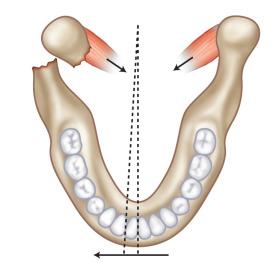
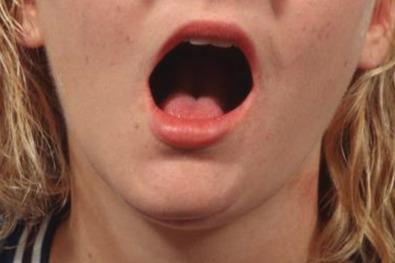
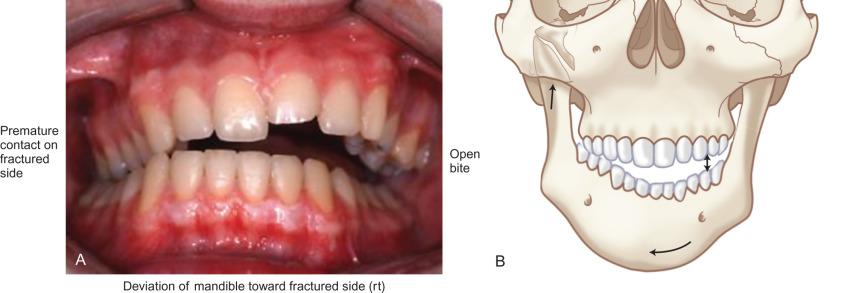
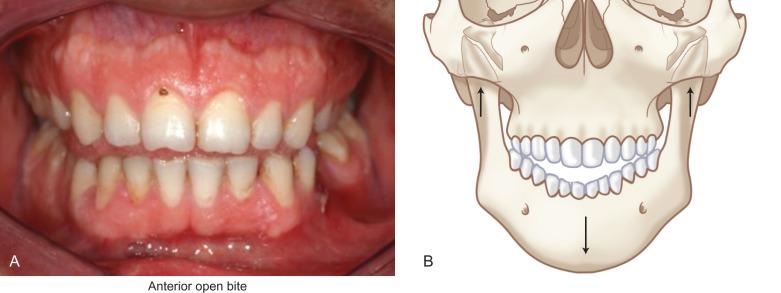
Some patients who sustain mandibular injury may present with pain in the joint and a malocclusion where the mandible comes forward on the side of the injury or they may not be able to bring the teeth together on that side and yet a fracture of the condylar process cannot be identified on imaging. In such instances, one should suspect a contusion/hematoma within the affected joint.
The vast majority of condylar process fractures in adults can be identified using plain radiographs. It is important to get at least two radiographs 90° to the other. For instance, the combination of panoramic and Towne's projections offer most of what might be needed to prescribe treatment in the vast majority of patients ( Fig. 1.15.5 ). Plain films are not as useful for pediatric condylar process fractures because the bone is less dense, the condylar neck is much shorter, and often the fractures are through the condylar head, which are not revealed well with plain films. On the other hand, if the surgeon routinely treats condylar process fractures in children closed, the need for more detailed imaging (CT) may not be warranted given the need for more radiation to do so.
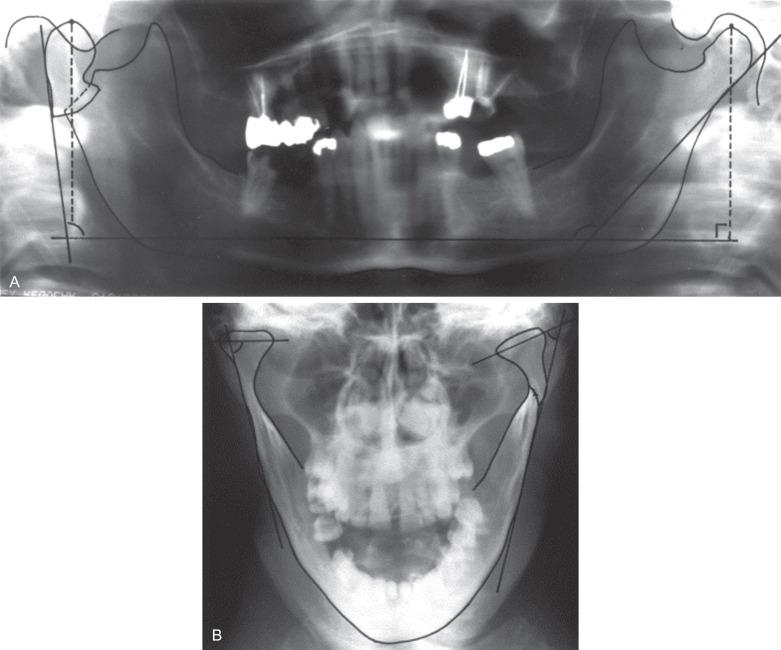
The main limitation of plain radiographs is that they do not give three-dimensional details of the fracture. Computed tomography (CT) is almost universally available today and most patients will already have a scan performed by the emergency department before a surgical consultation is made. CT gives extremely good detail of the position of the fracture(s) and the displacement of the segments. It is especially good for intraarticular fractures ( Fig. 1.15.6 ). CT scans cannot show the position of the intraarticular disk but the need to have that information available for treatment planning purposes is a hotly debated topic (discussed later). Should one desire more information on the position of the disk, a magnetic resonance imaging (MRI) scan would be needed as this is the imaging modality that provides the best view of the disk and other soft tissues within the joint.
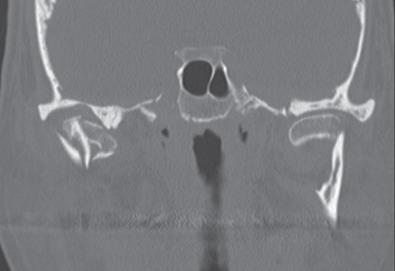
Controversy exists with respect to terminology and classification of condylar process fractures. Practitioners in Europe and North America may refer to the same entity with different words. For the purpose of this chapter and to clarify the vocabulary, it is important to make a distinction between the following terms:
Displacement. Displacement refers to the relationship of the fractured ends of the bones to one another. Often arbitrarily broken down into mild, moderate and severe displacement, it can be used for fractures throughout the skeleton whereas “dislocation” and “luxation” (see below) can be used only for fractures that involve a joint. The amount of displacement and its direction can be quantified by measuring the angle the condylar process makes with the ramus of the mandible in both the sagittal and coronal planes ( Fig. 1.15.5 ). A fracture that is displaced 90 degrees medially is one that is also dislocated because the articular surfaces will no longer have much contact. The relationship of the fractured ends can be further classified as those with medial and those with lateral override (displacement) of the segments ( Fig. 1.15.7 ).
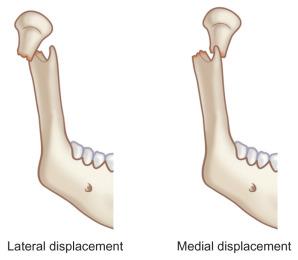
Dislocation (aka Luxation). Dislocation refers to the lack of relationship of the articular surfaces to one another. It usually indicates that the articulating surface of the mandibular condyle is mostly not contacting the articulating surface of the glenoid fossa ( Fig. 1.15.8 ). To be dislocated, the fracture would have to be severely displaced (see above).
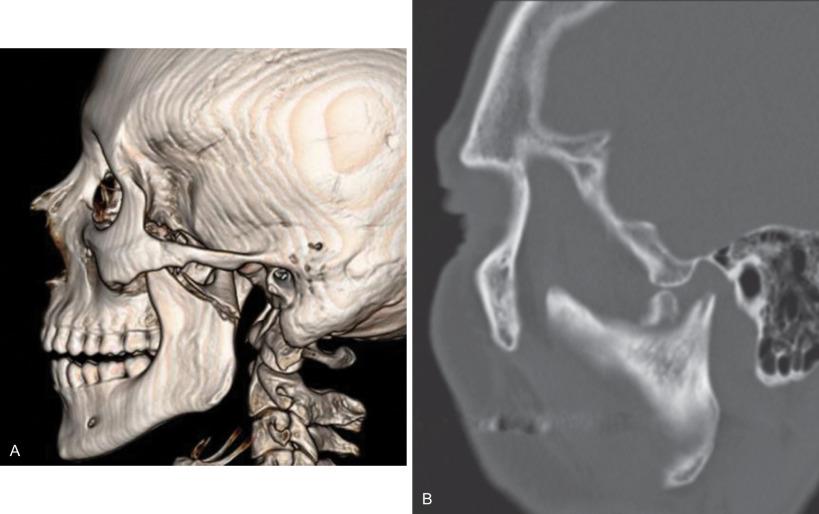
Subluxation. Sometimes the term subluxation is used to describe a partial separation of the articular surfaces but the condyle is not completely dislodged outside of the glenoid fossa. The difference between subluxation and dislocation (and luxation) is a matter of degree in that the articulating surfaces are not contacting.
Diacapitular (fractures). This is another European term that is used when the fracture line starts at the articular surface, goes through the head of the condyle and may extend outside the capsule. So it extends from within the capsule to outside the capsule ( Fig. 1.15.9 ). These types of fractures are also known as intracapsular fractures , especially in North America. However, it has been shown that in a large number of “intracapsular” fractures, the fracture extends inferior to the capsule on the medial aspect. The name “intracapsular ” therefore may be anatomically incorrect in such cases.
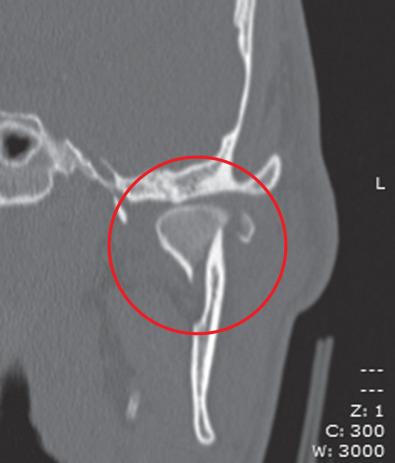
There are many classification systems in the literature. Classification systems are used for two main purposes. One is to categorize injuries so their treatment may be studied. For this purpose, the classification system must be very complete ( Table 1.15.1 ). Unfortunately, most classification systems used to adequately classify condylar process fractures for purposes of research are complex, cumbersome, and have very little clinical usefulness. The other purpose of a classification system is to help decide between the possibilities for treatment. Such systems do not have to be as complex and the ones that are used the most today by clinicians to classify condylar process fractures are based on the level or anatomic position of the fracture(s) (i.e., head, neck, subcondylar) ( Fig. 1.15.10 ) and the magnitude and direction of displacement of the fragments ( Fig. 1.15.5 ).
| SPECIFIC LEVEL 3 CONDYLAR PROCESS SYSTEM | SUBREGIONS | ||||
|---|---|---|---|---|---|
| Parameters | Code and Description | Process | Head | Neck | Base |
| Location | M |
x | |||
| Fragmentation | 0 |
x | x | x | |
| Vertical apposition | 0 |
x | |||
| Sideward displacement | 0 |
x | x | ||
| Direction a |
x | x | |||
| Angulation | 0 |
x | x | ||
| Direction a |
x | x | |||
| Displacement head fragment/fossa | 0 |
x | |||
| Direction a |
x | ||||
| Displacement caudal fragment/fossa | 0 |
x a | |||
| Direction a |
x a | ||||
| Distortion of condylar head | 0 |
x | |||
| Overall loss of ramus height | 0 |
x | |||
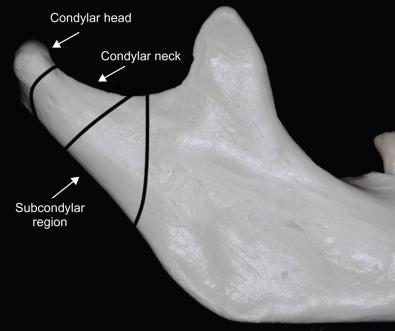
The “level” or anatomical position of the fracture is a method of broadly classifying fractures. Although a debated issue is the exact anatomic position of the divisions, a simple method is to divide condylar process fracture into three types: condylar head, condylar neck, and subcondylar region ( Fig. 1.15.10 ). A condylar head fracture is one at the level of the joint capsule, so the fracture is essentially intracapsular or possibly diacapitular. The neck of the condylar process is from the joint capsule above to the level of the sigmoid notch below. Anything lower than that is considered a subcondylar fracture. The main usefulness of such a classification is that it directly correlates with the possibility of placing stable bone plate osteosynthesis across the fracture. For example, most condylar neck and all subcondylar fractures are amenable to stabilization with standard 2.0 mm bone plate osteosynthesis whereas intracapsular fractures through the condylar head are often not treated open by most surgeons except those skilled in temporomandibular joint surgery.
Become a Clinical Tree membership for Full access and enjoy Unlimited articles
If you are a member. Log in here